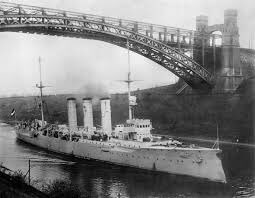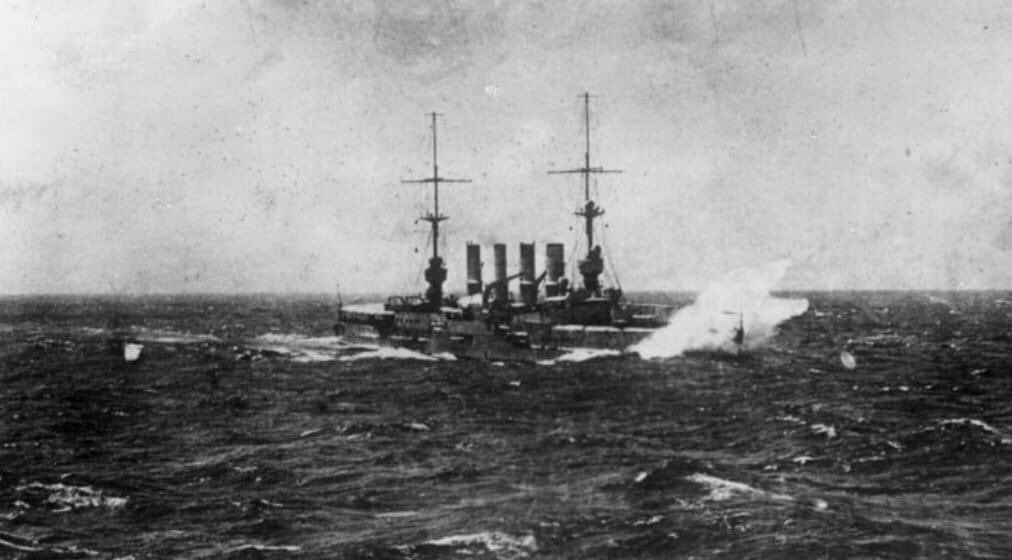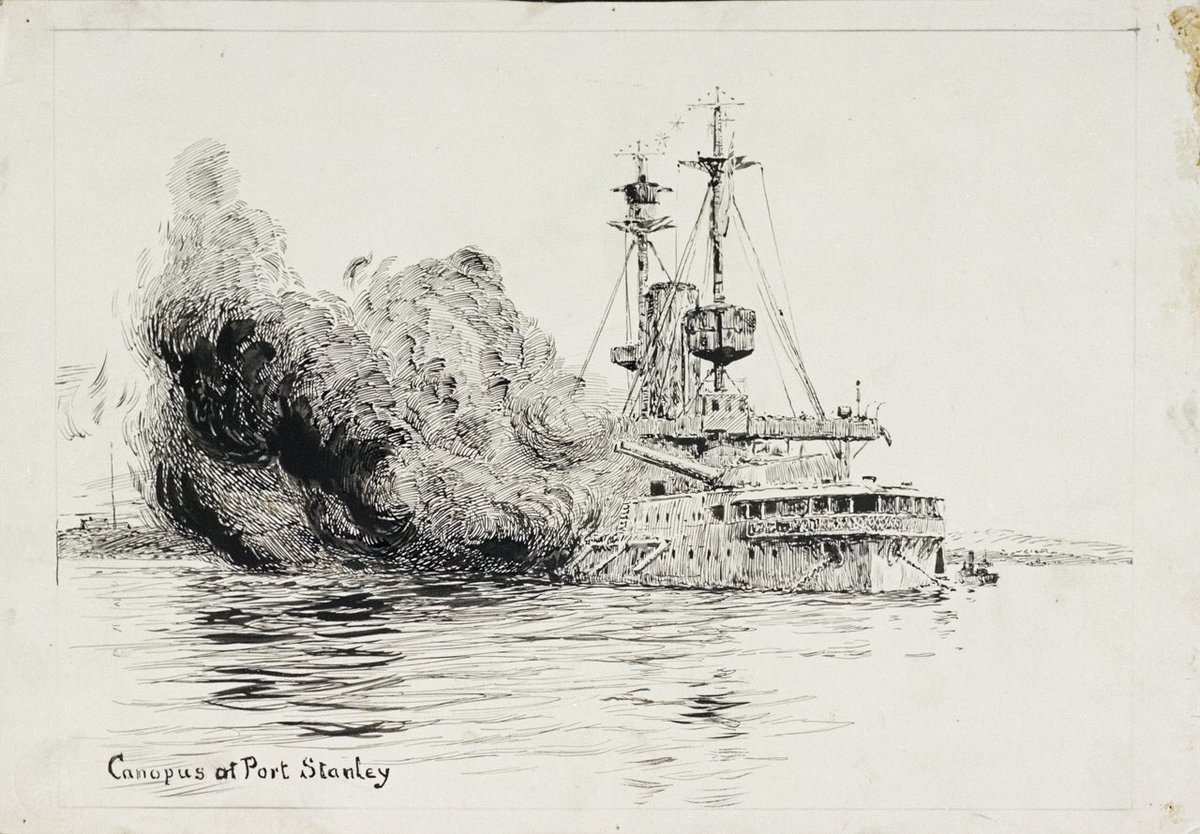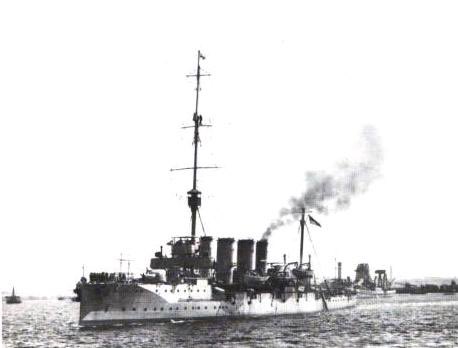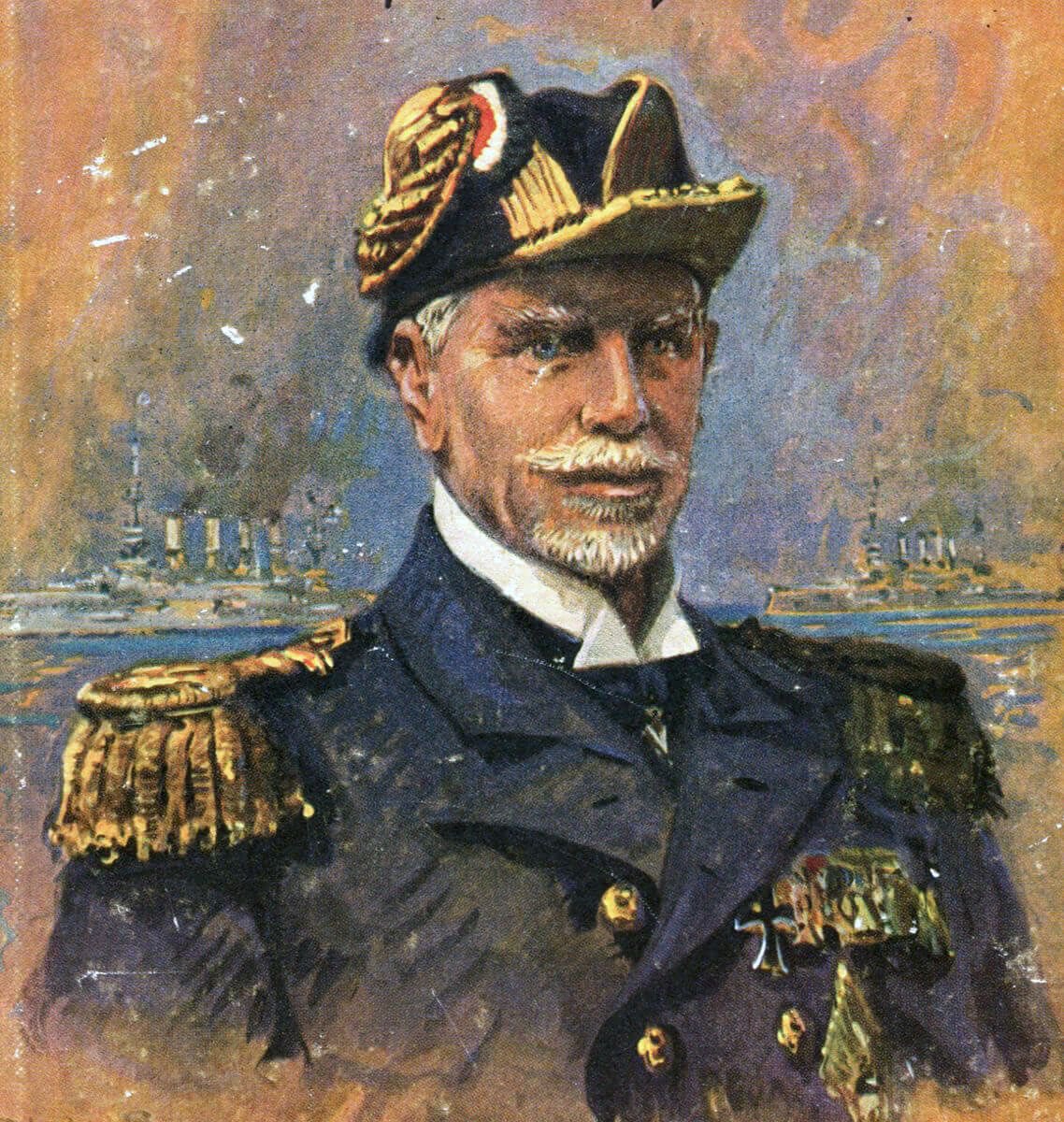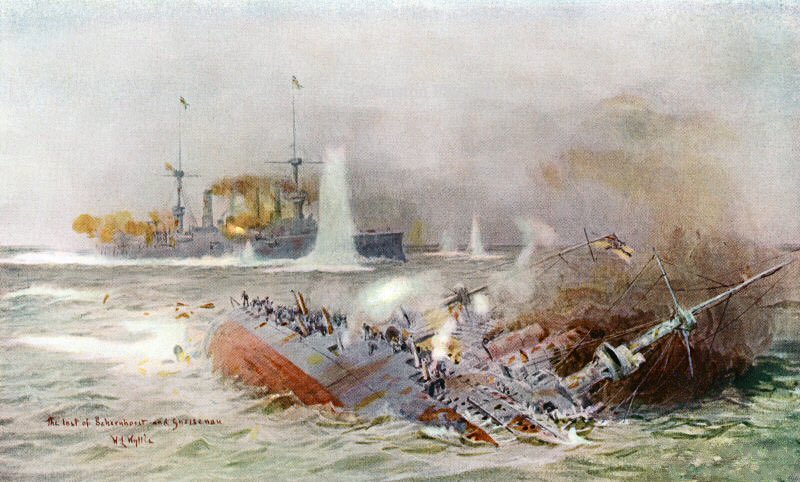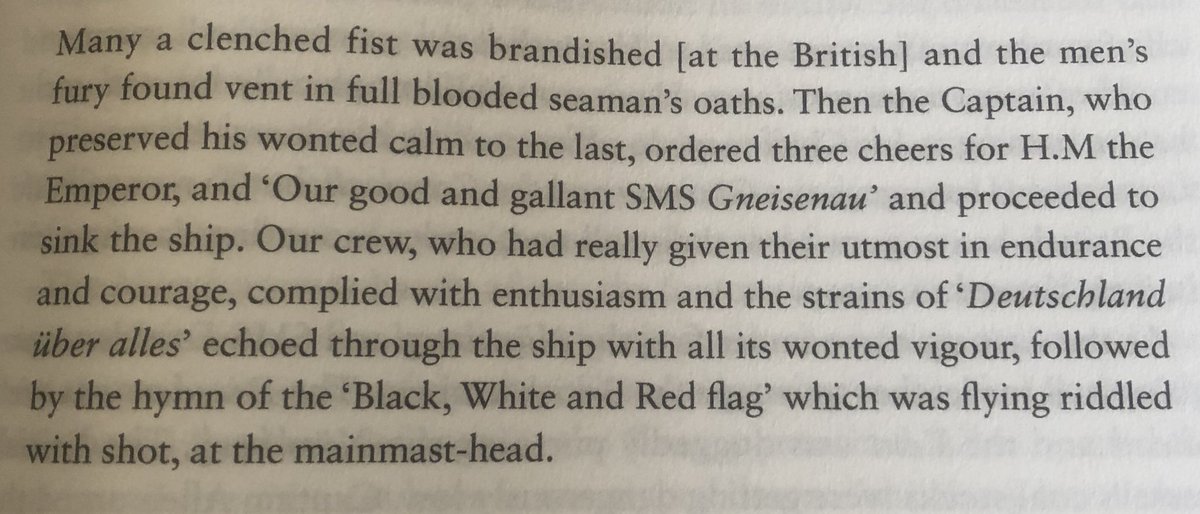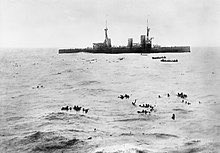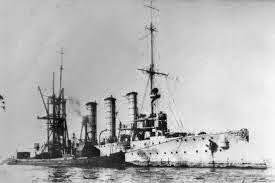106 years ago today Vizadmiral von Spee of German Ostasiengeschwader approached the Falkland Islands for what was hoped would be a small scale operation but turned into an all day naval battle that culminated in the loss of all but two of his vessels and 2000 of his men.
From August the Ostasiengeschwader (East Asian squadron), which was based at Tsingtau in China and policed the German Pacific empire, had been on the run across the Pacific with actions at Tahiti and occupying Easter island.
On November 1 1914 von Spee engaged Admiral Craddock’s American squadron off Coronel and used the setting sun to his advantage sinking the two abeitish armoured cruisers Good Hope & Monmouth with all hands
After stopping at Valparaiso for repairs, coal and resupply and another stop at Easter Island to plan they left for the Cape pausing at St Quentin bay to coal for 5 days leaving 21 November.
With coal supplies running low due to a storm which washed much of the extra supplies off the light cruiser’s decks & with SMS Dresden reporting she couldn’t make the supply point of Montievedio von Spee came up with a plan to resupply & embarrass the British
The Falkland Islands were a remote naval base and would have a large supply of coal. To get revenge for the loss of Samoa von Spee decided that the armoured cruiser Gneisenau & light cruiser Nürnberg would approach. Marines would land, secure the coal & island’s governo
Kapitän z. See Ludecke (Dresden) Haun (Leipzig) and Maerker (Gneisenau) argued against the plan but with a German agent reporting Adm. Stoddart’s squadron was not at the Falklands and the admiral decided to proceed.
Critically the German agents who knew that Vice Sturdee was sailing south along the east coast of South America with two battle cruisers neglected to report it to von Spee or Berlin. The British combined fleets of Stoddart & Sturdee arrived at Falklands on 7 December
At 5 am the Gneisenau & Nürnberg approached the island with Gneisenau preparing to take the outer roads of Port William & provide covering fire for Nürnberg as she went into Port Stanley and sank any ships they found. Marines were on the deck of Gneisenau preparing to land
The approach of the German ships was spotted by the pre-dreadnought Canopus which had been beached to act as a fortress and she opened fire. Though most of their shells missed one struck Gneisenau’s funnel & both ships turned and fled back towards von Spee’s main fleet.
German lookouts reported a large pall of smoke and dust over the ports which showed the British were probably burning their coal supplies whilst at the same time there were tripod masts seen in the distance. von Spee believed these were elderly Queen class pre-dreadnoughts
All would be well if the supply ships detached and went south east whilst the Ostasiengeschwader went east at speed. They would soon regroup and go back to heading for Uruguay & promised neutral supplies.
With the signal passed from Canopus to Sturdee he ordered steam to be risen in his resupplying warships and the colliers to move away. He didn’t want to get caught in the harbour like fish in a barrel. 25 minutes later HMS Glasgow, Invincivle & Inflexible left port
The fleet proceeded after the Germans at a leisurely 19 knots and lunch was served as normal at 11:45
News reached the fleet that 3 ships were seen approaching the islands filled with German marines so the light cruiser Bristol was detached with auxiliary Macedonia
News reached the fleet that 3 ships were seen approaching the islands filled with German marines so the light cruiser Bristol was detached with auxiliary Macedonia
At 12:30 the Bristol reaches Point Pleasant and began searching. At 15:30 they found the Santa Isabel & Baden and Bristol fired on them. The supply ships stopped and their crews removed before Bristol sank them both with gunfire.
Meanwhile at 12:20 Sturdee passed the order to open fire and his two battle cruisers increased speed to 26 knots. The rear most ship, Leipzig, came under fire at 12:50 but the British smoke & vibrations made targeting difficult and slow.
At 13:20 von Spee decided to buy time for his light cruisers to escape & May even damage the two battle cruisers. Scharnhorst & Gneisenau turned north east to engage the British ships at close range to use their 8.3” & 5.9” gun’s as the light cruisers fled at speed.
“The German firing was magnificent to watch. Perfect ripple salvoes all along their sides. A brown-coloured puff with a centre of flame marking each gun as it fired.... they straddled us time after time” observed one British officer.
Sturdee moved to keep the Germans at longer range and unable to use their smaller guns and torpedoes but this made British gun fire less accurate which was exacerbated by smoke & reservist crews.
The Germans turned and crossed the British T and gave broadsides
The Germans turned and crossed the British T and gave broadsides
The German shells were devastatingly accurate but bounced off the British armour. The British returned fire with 12” shells smashing the German vessels as if they were made of China.
The Scharnhorst’s admiral’s standard slipped to half mast and Maerker on Gneisenau feared the worse & signaled Kpt Schultz on Scharnhorst believing von Spee was dead
“I am alright so far. You were right after all” came the response from his old friend. A final order came for Gneisenau to try and make a break for freedom too.
Scharnhorst moves towards the British ships & although she listed to port her engines pushed her forward, her flags flew from the mast and the gunners bravely fired. Pochammer, Gneisenau’s XO described the sister ship as;
“Funnels are fallen, smoke was pouring out. Flames were visible inside the vessel through shot holes and scuttles. But her guns crashed out furiously and without intermission”
She drew all of the British fire as she turned to give one last broadside.
She drew all of the British fire as she turned to give one last broadside.
With the decks flooding and the decks on fire Scharnhort’s fore turret fired one last round with the sea only 6’ away from it. The cruiser slipped beneath the waves in a cloud of steam, her propellers still turning with her whole 840 crew.
Pochammer believed the pall of smoke seemed to say:
“Scharnhorst waits for the Gneisenau”
“Scharnhorst waits for the Gneisenau”
Gneisenau was in a poor state as well with her hull deeply holed, the dressing room took a direct hit killing the wounded and the Fleet surgeon. Maerker was also under fire from the two battle cruisers and Stoddart’s armoured cruiser, Carnarvon so ordered “Abandon Ship”
200 men entered the water of a crew of 764 but only 166 were rescued with men dying of exposure to the cold & attacked by Albatrosses
Meanwhile the light cruiser Glasgow and armoured cruisers Kent & Cornwall pursued the light cruisers Dresden, Leipzig & Nürnberg with Leipzig coming under fire at 14:50.
Despite only 4 of Leipzig’s guns able to fire they managed to damage Glasgow’s boilers
Despite only 4 of Leipzig’s guns able to fire they managed to damage Glasgow’s boilers
Glasgow held back and engaged the Leipzig at range and at 16:42 the Cornwall moved up & at 17:00 gave her a full broadside setting her on fire. Haun was told his guns were now all spent so they tried torpedoes to no avail.
The Kent was low on coal but managed to get to the unprecedented 25 knots in pursuit of the Nürnberg. Von Schönberg’s vessel fired well but couldn’t penetrate the Kent’s armour but took two shots beneath the waterline damaging the steering mechanism & at 17:35 her boiler exploded
Kent closed and poured fire on the stricken German cruiser at 18:25 the Nürnberg was stopped. As a couple of her guns were still firing the Kent gave her another broadside. With the vessel sinking but her flag still flying Kent gave her another volley - the flag was ripped down
Nürnberg lowered a lifeboat full of wounded which promptly sank & at 19:26 Nürnberg rolled and sank. Most of Kent’s lifeboats were holed and so a rescue response was slow & only 20 men were saved with three dying later. Captain Allen later reported
The Dresden escaped into a rain storm with the Glasgow unable to chase her. The hospital ship Seydliyz similarly escaped.
The Leipzig was not more than a burning wreck with Kpt Haun ordering his crew on deck to evacuate. There was an explosion and Glasgow, believing she was under fire wracked the deck killing many more. A fire erupted around the flag meaning it couldn’t be pulled down
The British continued to fire into the wreck whilst handfuls of survivors took cover & at 20:12 launched two green flares. Glasgow believed that was a surrender attempt & held fire. At 20:45 lifeboats were sent over to the wreck & at 21:23 she too slipped beneath the water
In total 2000 German sailors were lost to the sea or captured.
The Royal Navy lost 10 men killed.
The Royal Navy lost 10 men killed.
The German order of battle was:
Armoured Cruisers Scharnhorst & Gneisenau
Light cruisers Nürnberg, Leipzig & Dresden
Supply ships Baden, Santa Isabel and Seydliyz
Armoured Cruisers Scharnhorst & Gneisenau
Light cruisers Nürnberg, Leipzig & Dresden
Supply ships Baden, Santa Isabel and Seydliyz
The British order of battle was: Battle cruisers Invincible & Inflexible
Armoured cruisers Carnarvon, Kent & Cornwall
Light cruisers Glasgow & Bristol
Auxiliary Macedonia
Beached battleship Canopus
Armoured cruisers Carnarvon, Kent & Cornwall
Light cruisers Glasgow & Bristol
Auxiliary Macedonia
Beached battleship Canopus
A young sailor, Richard Stumpf who was aboard the battleship Thüringen back in Germany wrote in hi diaries that;
“If the situation had been reversed & had our side possessed such superiority, the battle would have lasted a mere five minutes. Nothing would have been left of the...
“If the situation had been reversed & had our side possessed such superiority, the battle would have lasted a mere five minutes. Nothing would have been left of the...
Enemy. It is unbelievable that it should have taken the English with their thirty 30.5 caliber guns three to five hours to destroy a couple of old Armoured cruisers. Anyone having the slightest acquaintance with gunnery will agree that (had they been German ships)...
such a thing would never have occurred. A label of shame shall remain attached to this pitiful English victory for all time.”

 Read on Twitter
Read on Twitter